Are you trying to build backlinks to enhance the performance of your SaaS website? In this article, we’re discussing some effective link building strategies for SaaS companies as well as the steps of setting up a link building campaign, starting with audience research and ending with backlink monitoring. You’ll learn exactly how to build links for your SaaS business from our detailed steps and examples. So, let’s get started.
What is SaaS Link Building?
SaaS link building is a set of practices aimed at increasing the number of links pointing to your website pages. You need links because they show Google that your website is providing something of value. It could be information on a topic or a solution tailored to solving a particular problem.
Search engines are in the business of providing the most accurate search results. They are not willing to misdirect their users by pointing them to low-quality products that no one seems to use. And every link is like a vote in favor of your site. The more links you have, the better your chances of ranking high on SERPs.
While you need to generate many backlinks, it’s not about quantity! The links need to come from sites with high domain authority and rating.
Why is SaaS Link Building Important for SEO?
Here are 12 benefits of link building for SaaS brands:
- Improves search engine rankings: Link building is a crucial factor in search engine optimization (SEO). When other reputable websites link to your website, search engines like Google consider it a vote of confidence and boost your website’s rankings in search results.
- Drives more organic traffic: Higher search engine rankings from link building lead to increased organic traffic to your SaaS website, as users are more likely to click on the top results in search engine results pages (SERPs).
- Builds brand authority: Building high-quality links from authoritative websites in your niche helps to establish your SaaS brand as a thought leader and authority in your industry, which can enhance your brand’s reputation and credibility.
- Increases referral traffic: Links from other websites can drive referral traffic to your SaaS website, as users who click on the links are directed to your site.
- Diversifies your traffic sources: Link building can help diversify your traffic sources, reducing your reliance on any one source like paid advertising or social media.
- Improves user experience: When users are directed to your website from other authoritative sites, it signals to them that your site is trustworthy and valuable, which can improve their overall user experience.
- Builds relationships with other industry leaders: Engaging in link building can help you build relationships with other leaders in your industry, which can lead to other business opportunities in the future.
- Boosts content marketing efforts: Implementing a solid link building strategy can help you promote and amplify your content marketing efforts by getting your content in front of a larger audience.
- Increases brand exposure: Link building can help increase your SaaS brand’s exposure to a wider audience, especially if your links appear on high-traffic websites.
- Generates leads: High-quality backlinks can drive potential customers to your SaaS business, increasing your chances of generating leads and conversions.
- Lowers bounce rate: When users land on your site from high-quality links, they are more likely to engage with your content, reducing your site’s bounce rate.
- Enhances long-term SEO success: Investing in link building for your SaaS website can help enhance your long-term search engine optimization success, as building high-quality links is a long-term process that can improve your website’s authority and rankings over time.
Why is Organic Traffic so Important for SaaS Companies?
Organic traffic is valuable in the SaaS niche for several reasons:
- Organic traffic is free and can be a cost-effective way to drive traffic to your SaaS business. Unlike paid advertising, which can be expensive, organic traffic does not require a budget for ad spend.
- Organic traffic consists of visitors who have found your website through search engines or other online channels. These visitors are actively seeking solutions to their problems and are more likely to convert into high-quality leads.
- Organic search traffic is sustainable and can continue to drive visitors to your website long after you have created the content. This is because search engines like Google reward websites that consistently publish high-quality, relevant content.
- High-authority websites that rank high in search engine results pages (SERPs) are perceived as credible and trustworthy. This can help establish your brand as an authority in the SaaS niche and increase brand recognition.
Here are some examples of how organic traffic can benefit SaaS companies:
- A project management SaaS company that creates high-quality blog content on project management best practices can attract organic traffic from people searching for project management tips and solutions. This traffic can convert into leads and customers for the company.
- An email marketing SaaS company that creates informative, engaging content on email marketing trends and strategies can attract organic traffic from people looking to improve their email marketing efforts. This traffic can convert into high-quality leads and customers for the company.
- A CRM SaaS company that publishes valuable resources on CRM implementation, customization, and integration can attract organic traffic from people searching for solutions to their CRM-related challenges. This traffic can convert into leads and customers for the company.
There are many options, your task is to find yours.
What are the Key Differences Between SaaS Link Building and Link Building for Other Types of Businesses?
SaaS link building is different from link building for other types of businesses because of the unique nature of the SaaS industry. As you’re dealing with digital products and services, your website is more than a place to get information or directions. Here are more ways in which link building campaigns for SaaS companies are different:
Different target audience
SaaS companies have a highly targeted niche audience versus a more general audience. For instance, depending on the product’s functionality, it may be specific businesses such as hotels or individuals in a particular industry such as accountants. So, when undertaking SaaS link building, you’ll need relevant links, and these come from closely-related businesses so they can pass the most link juice.
Emphasis on high-quality backlinks
While high-quality backlinks are important for all types of businesses, they are especially critical for SaaS companies. This is because SaaS products are often complex and require a significant amount of trust from potential customers. High-quality backlinks from authoritative and reputable websites can help establish trust and credibility.
Focus on content marketing
SaaS companies often rely heavily on content marketing to attract and retain customers. This means that link building efforts must be aligned with content marketing efforts. You’ll need to create high-quality content that must be highly engaging and shareable to attract high-quality links.
Importance of referral traffic
Referral traffic is especially important for SaaS companies, as it can result in more qualified leads and conversions. This means that link building efforts must focus on building backlinks from relevant sites that are likely to generate good quality website traffic.
Different link building tactics
While some link building tactics used in traditional link building are applicable to SaaS companies, such as guest posting on websites that accept guest posts and broken link building, link building for SaaS companies also requires some unique tactics, such as building links from review websites and software directories that cater to the SaaS industry. We talked about most link building techniques in our guide to crypto link building.
In summary, SaaS link building requires a highly targeted and strategic approach that emphasizes high-quality relevant backlinks, content marketing, and unique link building strategies and tactics tailored to the SaaS industry.
How to Build a Link Building Campaign for a SaaS Website
Understand Your Target Audience
Trying to understand your target audience is not quite obvious when it comes to link building. But well, it’s the first step if you want to gain quality backlinks that don’t just improve your website’s domain authority but actually translate to more visits and sales.
So, where do you start? Begin by figuring out who will be the most likely to use your services and products. Who are those people, and what issues are they currently experiencing?
Don’t rely on assumptions alone. It’s crucial to rely on actual data to pinpoint your real audience group. Implement the following techniques to better understand your audience:
- Market Research: It’s important to comprehend not just the preferences and needs of your target audience, but also how they are currently addressing those needs. By doing so, you can provide them with a better solution that truly adds value.
- Buyer Personas: Using research and data about your existing customers, you build a fictionalized and representative profile of your ideal customer with attributes that make them human such as their age, name, address, occupation, goals, motivations, etc.
- Analyze Customer Behavior: It entails understanding how your target audience makes their purchase decisions by weighing how they are influenced by their emotion, mental state, current knowledge, and behaviors.
- Gather Customer Feedback: Sourcing first-hand customer feedback on your product allows you to understand how people think about your business or experience your product.
- Monitor Competitor Activity: You identify your main competitors and track their actions with the aim of identifying their strategies, strengths, and weaknesses to better compete.
Why Is It Important to Align Your Link Building Strategy with Your Audience’s Needs and Preferences?
So, what is the importance of aligning your link building strategy with the audience’s needs and preferences? Here are useful reasons:
Reason 1: You build relevant links that are more valuable to your link profile
If you want your link building initiatives to be effective, it’s essential to build links from websites that are relevant to your audience. Links from relevant sites are more valuable than links from irrelevant websites, as they are more likely to be clicked on and drive traffic to your website.
Reason 2: Your link building ultimately leads to a better user experience
When you create content that is relevant to your audience’s needs and preferences, you provide a better user experience. This can lead to increased engagement, longer time on site, and higher conversion rates.
Reason 3: You stand out for your quality, allowing you to outrank similar competitors with similar content and products
Google uses complex algorithms to rank websites based on a variety of factors, including the relevance of their content. By aligning your link building strategy with your audience’s needs and preferences, you increase the chances of your website ranking higher in search results, which can drive more traffic to your website.
Reason 4: You establish your brand as a leader in the niche
When you’re closely aligned with your audience’s interests, pain points, and needs, it’s much easier to create content that is relevant, valuable, and helpful. That allows you to grow into a thought leader, leading to increased trust and credibility. Ultimately it will translate to more links, traffic, and long-term relationships.
Tools and Techniques that Can Help You Gather Data on Your Audience
The following tools and techniques can help you to better understand your SaaS audience.
Google Analytics
Google Analytics is a free tool that provides valuable insights into your website traffic. You can use it to track user behavior, such as which pages users visit, how long they stay on your site, and where they come from.
Surveys
Conducting surveys allows you to gather feedback from your audience even in real-time as they interact with your product. You can use tools like Google Forms, SurveyMonkey, or Typeform to create and distribute surveys.
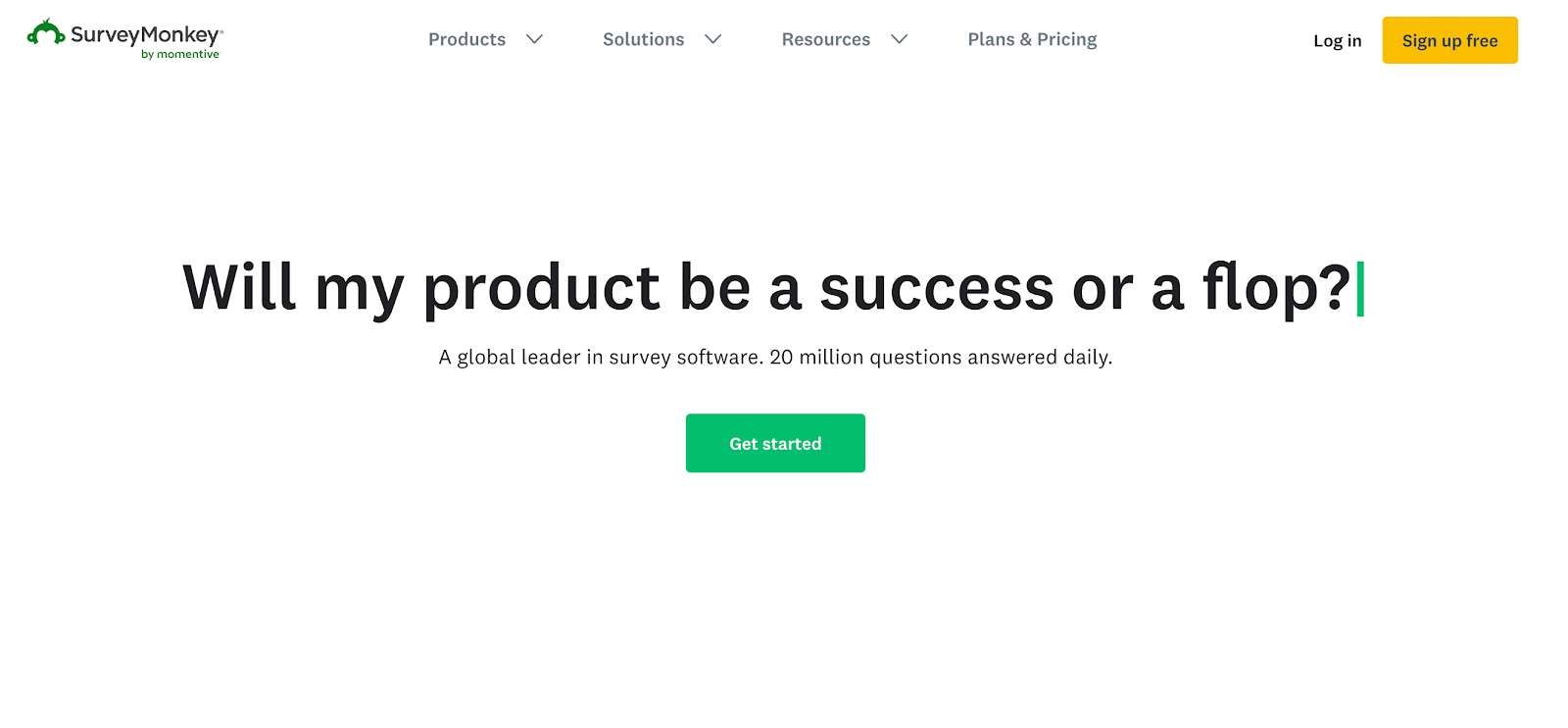
Social Media Analytics
Social media platforms like Facebook, Twitter, and LinkedIn come with in-built analytics tools that allow you to track engagement metrics like likes, shares, and comments. You can use this data to understand which types of content resonate with your audience and adjust your strategy accordingly.
Keyword Research
Keyword research tools like Google Keyword Planner, SEMrush, and Ahrefs can help you identify the search terms and phrases that your audience is using to find information related to your product or service.
For example, we often use Ahrefs and its Keywords Explorer:
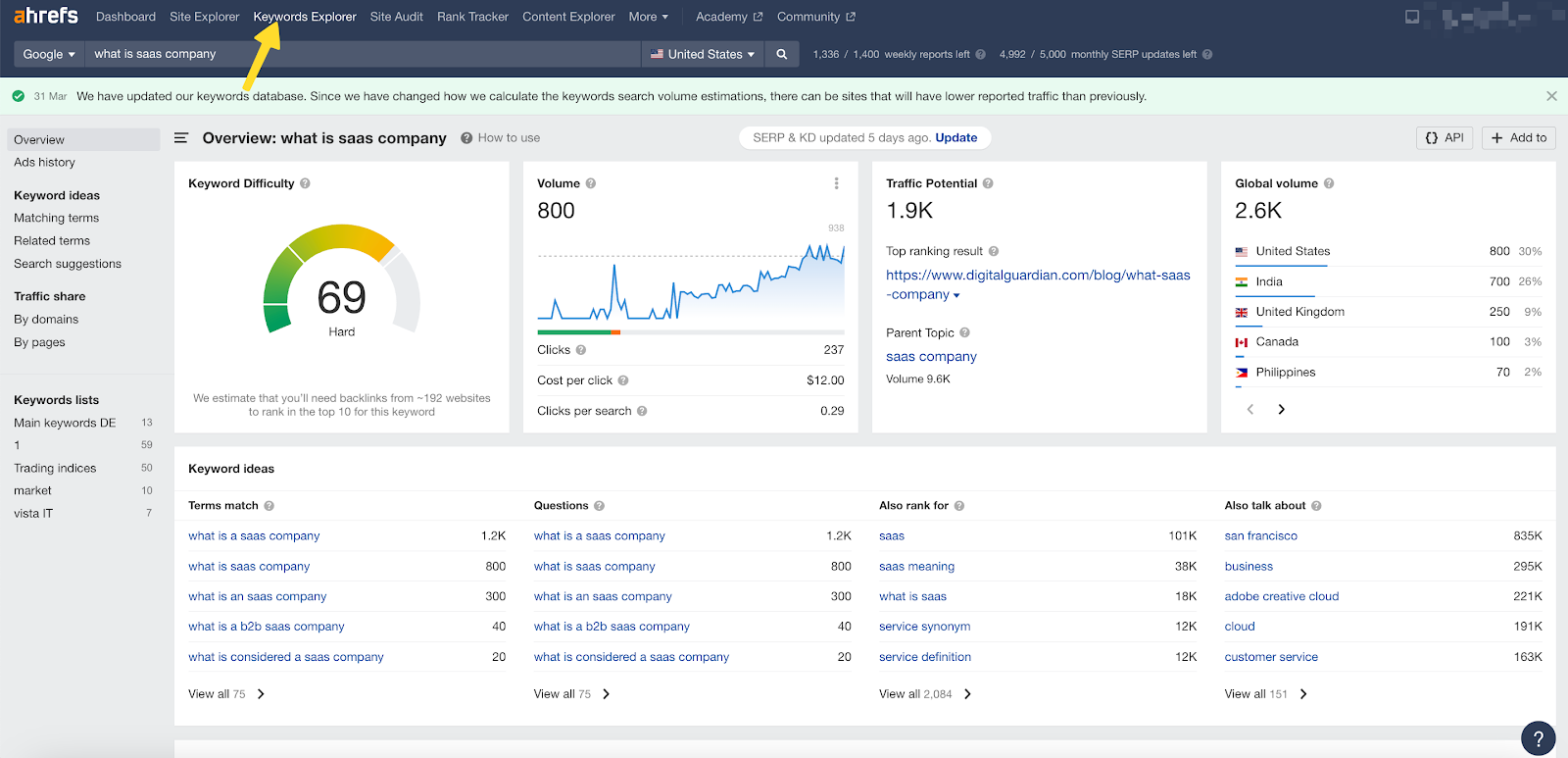
Customer Support Interactions
Your customer support interactions can provide valuable insights into your audience’s needs and pain points. Reviewing customer support tickets, emails, and chats can help you identify common issues that your audience is facing and adjust your strategy accordingly.
Website Heatmaps
Heatmap tools like Hotjar or Crazy Egg provide visual representations of user behavior on your website. You can use this data to understand where users click, how far they are scrolling, and what content they engage with.
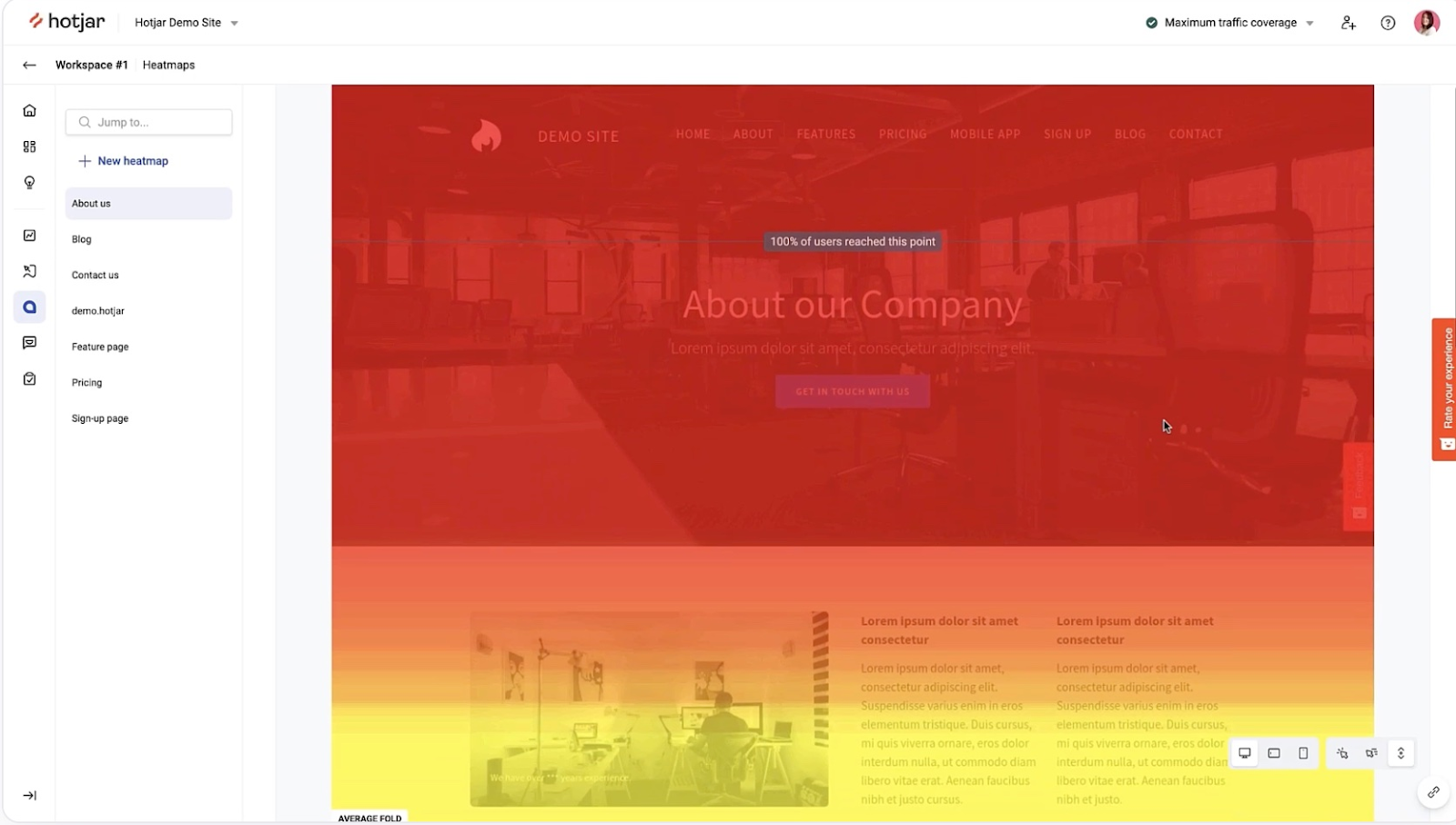
By using these tools and techniques, you can gather data on your audience and use it to create a more effective link building strategy.
Identify Your Competitors
You need to identify your biggest competitors to see which strategies they are using to get to the top. But you will need to weed out all the garbage and figure out which websites your potential customers use.
How do you end up with a definitive list of worthy competitors? Well, you must know the following:
- What keywords do you get traffic for, and do they overlap with your competitors?
- Which keyword groups are important to you?
- Which sites intersect in the search results for your priority clusters, and how many of them?
- Which competitor pages are generating traffic for your keywords – are they product pages, service pages, or blog pages, or is it the home page?
- What is the content on such competitor pages, why does it build backlinks and why is it driving organic traffic?
Have you identified your competitors? Now let’s move on.
Find Out Which Sites Link to Your Competitors
By finding out which sites your competitors are getting links from, you will solve several problems at once:
- Collecting the first base of sites for exchanging links;
- Understanding which sites link to your competitors and which ones are better not to take;
- Finding out how many sites link to your competitors.
The easiest way to find sites where your competitors get their links from is with the Link Intersect tool from Ahrefs:
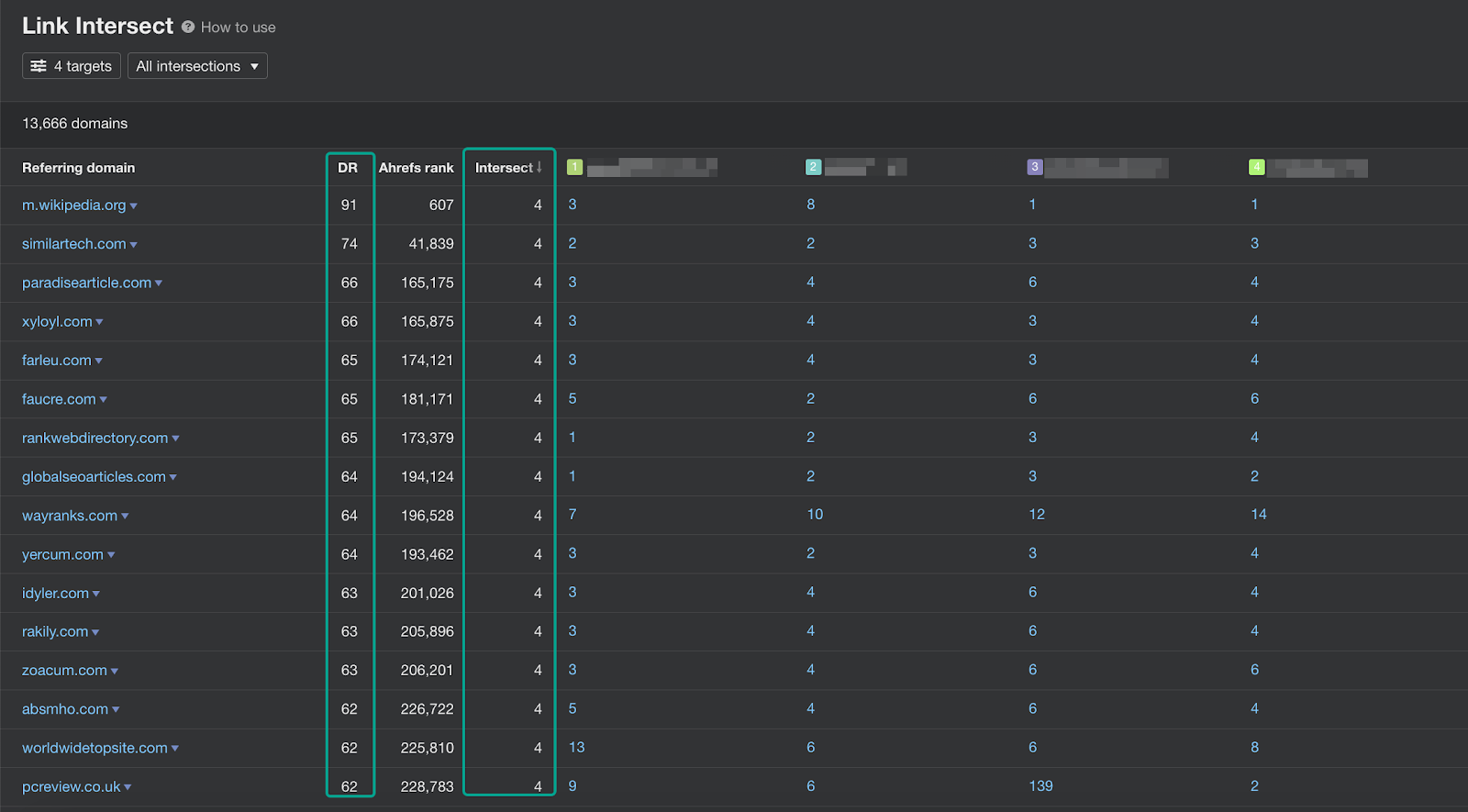
Screenshot caption: Sites that link to SaaS competitors.
It helps you cross-reference the sites linking to your competitors, which will help you identify the most popular ones.
Analyze Your Competitor’s Links
Generating a list of domains linking to your competitors’ websites is only the first part of the equation. Next, you need to carry out a much deeper analysis of their link profiles to find out:
- What types of links do competitors use?
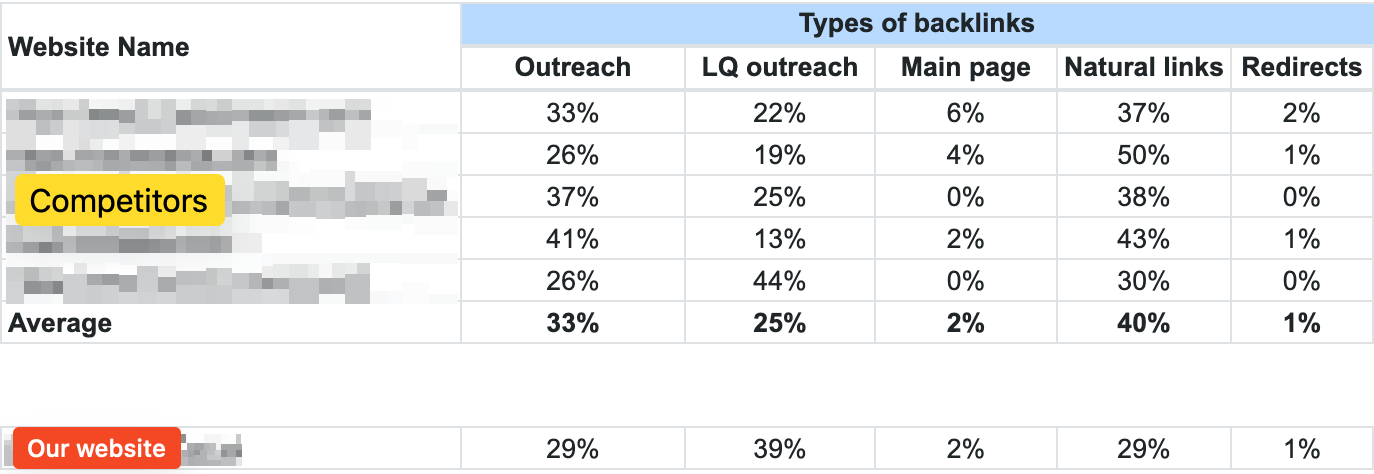
- What anchors do they use and in what ratio?
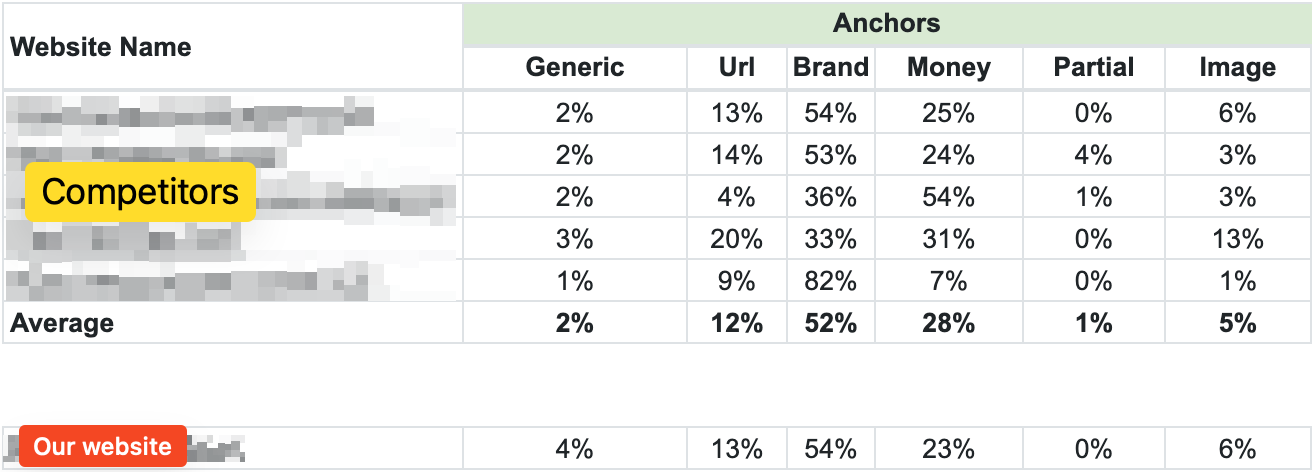
- What is the ratio of Dofollow links and Nofollow links?
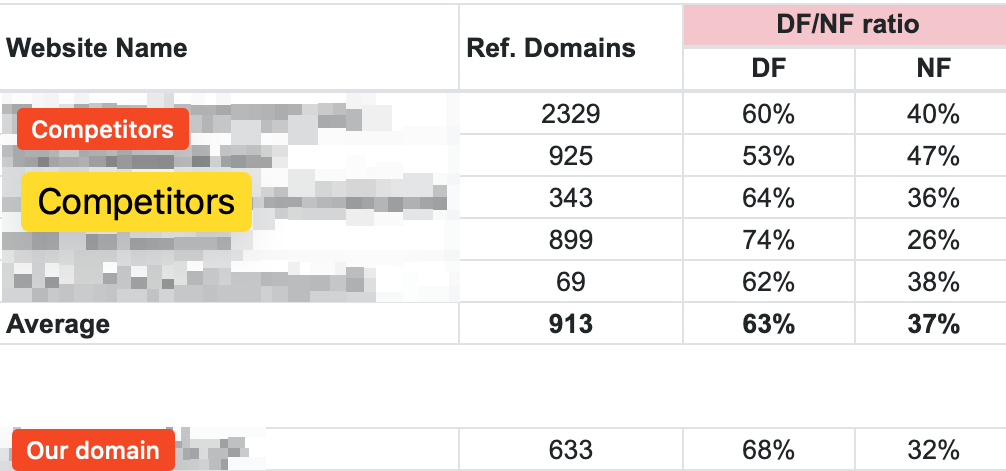
- What are their link growth dynamics and total DR/DA of referral domains?

Creating a dashboard and analyzing data will help you form an opinion about a niche, and give you an understanding of where to start and what to focus on during link promotion.
*We collected data thanks to various tools such as Ahrefs and Majestic. The visualization is arbitrary to provide a general understanding of what it might look like.
Tip: Next, we start the process of building links. We talked about how it looks in the example of crypto link building.
What Types of Links Are Better to Use for Your SaaS Link Building Strategies?
You have analyzed your competitor’s link profiles and derived insights on which types of links they have and where they get them from. But before reaching out to these sites, you need to sort them out based on how much value they can provide.
The sites will fall into two main categories, fundamentally. First, we have primary sites that comprise authoritative websites (with a good share of search traffic and high rankings) and niche blogs (that have the highest correlation with the content you want to produce).
The second category will be secondary sites that can still enhance the relevance of your website. Examples of such sites include:
- Tech news websites;
- Business directory sites such as Сlutch and others;
- News websites;
- Product review sites;
- Etc.
By building links from primary and secondary websites, you will make your backlink profile more diverse, as well as draw attention to your brand to a wider audience.
Create Useful and Shareable Content Taking Into Account SaaS Specifics of Your Site
If you want to build links, you need to create content that other websites will link to. Additionally, you must create content that naturally motivates users to share it. This way, you will be able to get natural backlinks from your users, which will strengthen your link profile.
Let’s look at Hubspot’s example. They not only have one of the leading CRM and marketing software, but the SaaS company is also familiar with the aspects of creating quality content that drives traffic and links.
Many of their blog pages have been hugely popular, for instance, the “Best cover letter examples” page has an average organic traffic volume of 260,000, and the page has accumulated links from over 1,100 referring domains. This tells us that they did not just optimize the article for key queries, but created really useful content.

Encountering such a stellar page may cause one to lose heart, thinking that it can be nearly impossible to achieve such a result or even compete with such a page.
But it’s quite possible to match such results with SaaS link building techniques like providing a free tool related to what you’re currently offering. To illustrate this, let’s consider Grammarly.
The hugely popular grammar checker provides a free Plagiarism Checker tool that is useful for both copywriters and search engine optimization specialists. And now let’s see what such a seemingly free tool can provide for your site:

The plagiarism checker has generated 1.4 million in organic search traffic valued at $240k, and the page has received links from 2400 referring domains.
So, with such a free tool, here is what the user gets from you:
- Receives a free tool to solve their problems;
- Positive brand experience.
In return, the user can also provide you with the following benefits:
- Share a link to your tool;
- Subscribe to the service;
- Recommend your service to colleagues.
Therefore, when working in the SaaS niche, it’s important to be aware of what your users need, which is not obvious at first glance. You may need to have an actual conversation with them first, or to learn about their needs from direct observation by offering a free tool that solves some of their needs for free.
Think About What Content You Would like to Convey to Your SaaS Audience
In link building for SaaS, as well as in other areas, you do not need to post hastily written text on the site where you have negotiated to have your links placed through niche edits or guest posting. Even as you promote your links, the overall goal is to enhance your target audience’s experience and position your brand as a premier source of information and expertise on a topic.
You can follow some handy tips to ensure that you’re creating the best content, even if it’s published on another site:
- Do research: Analyze the information needs of your users using search queries. Additionally, put yourself in their shoes and think about what they expect to see whenever they click on a link that is pointing to your website. Be clear about why they are clicking on the link and what they can expect to see on the other side, for instance, by providing sufficient context and using descriptive anchor text.
- Think about writing something original and helpful: You’ll not be enhancing your audience’s knowledge or solving any problems if you’re just providing the same information that is already out there. Try to come up with something thoughtful and original that can be quoted. You can reveal new ways of addressing existing issues or share your first-hand experience and lessons learned from expertly doing something.
This way you will help the partner site get additional traffic and more inbound links, further enhancing the link juice that you can potentially get. And if your guest post happens to be quite popular, it also means more traffic from that website for you. This is the basis of “quality link building“.
The same principles should apply to the information that you post when you use guest posting, forum links, social networks, and other types of links. The main thing is not just to get a link from a trusted resource, but to benefit yourself and others, which will help your link profile become stronger.
Additionally, content is not just text and pictures. You should go the extra mile and discover which other kinds of content can appeal to your users. For instance, they may be more appreciative if the information was presented as an infographic, chart, table, checklist, etc.
How to Create Useful Content for Link Building
You should start by building a keyword list for the article by finding out the best topics to write about. It’s similarly important to consider the information needs and gaps that exist by looking at the questions users ask.
In Ahrefs, plug in your main keyword or topic and explore the list of matching terms under Keyword Ideas:
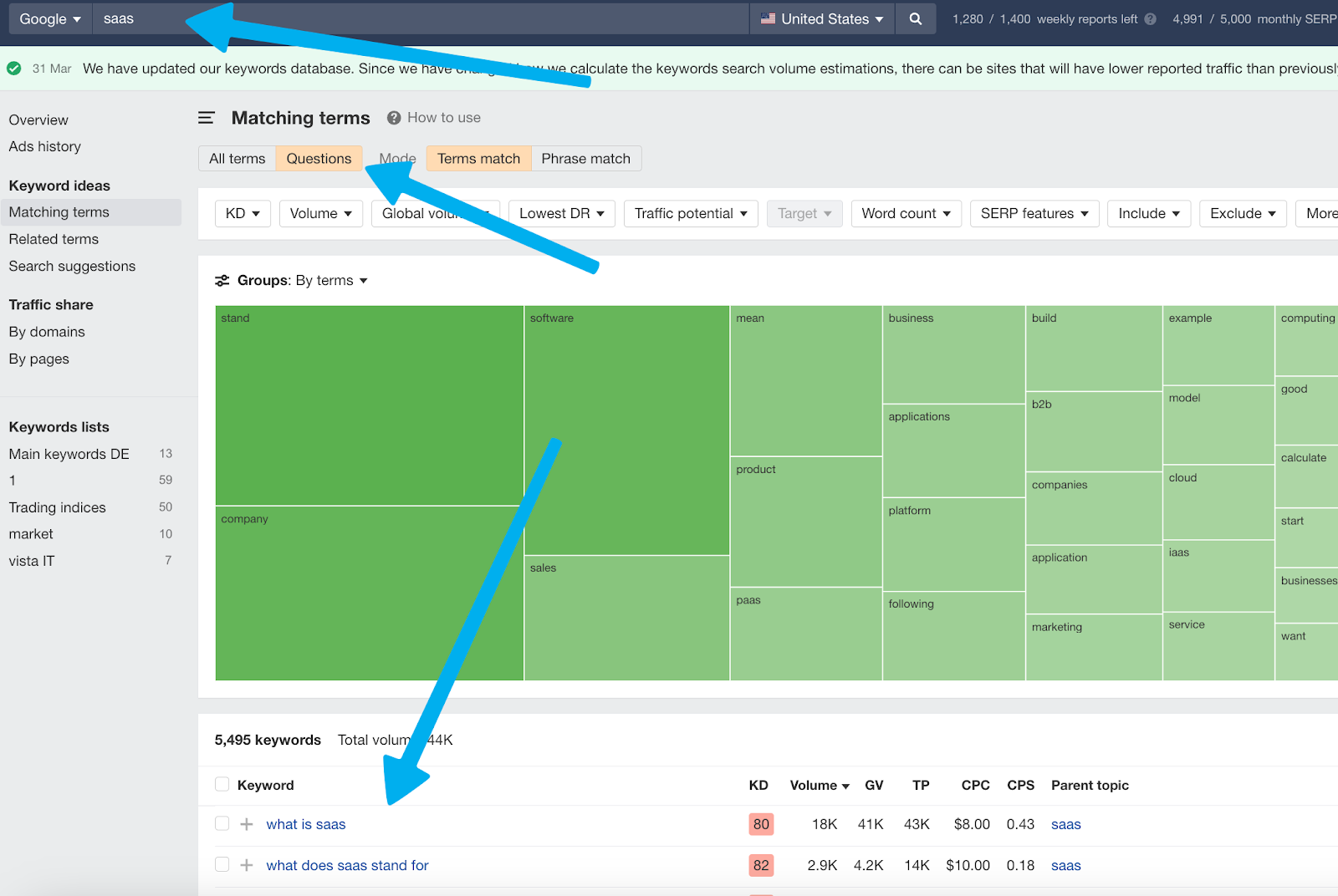
From the recommended list of keywords, you can carry out additional analysis to understand the keywords’ popularity (search volume), the level of competition (keyword difficulty), etc. to pick the most suitable keywords for your article.
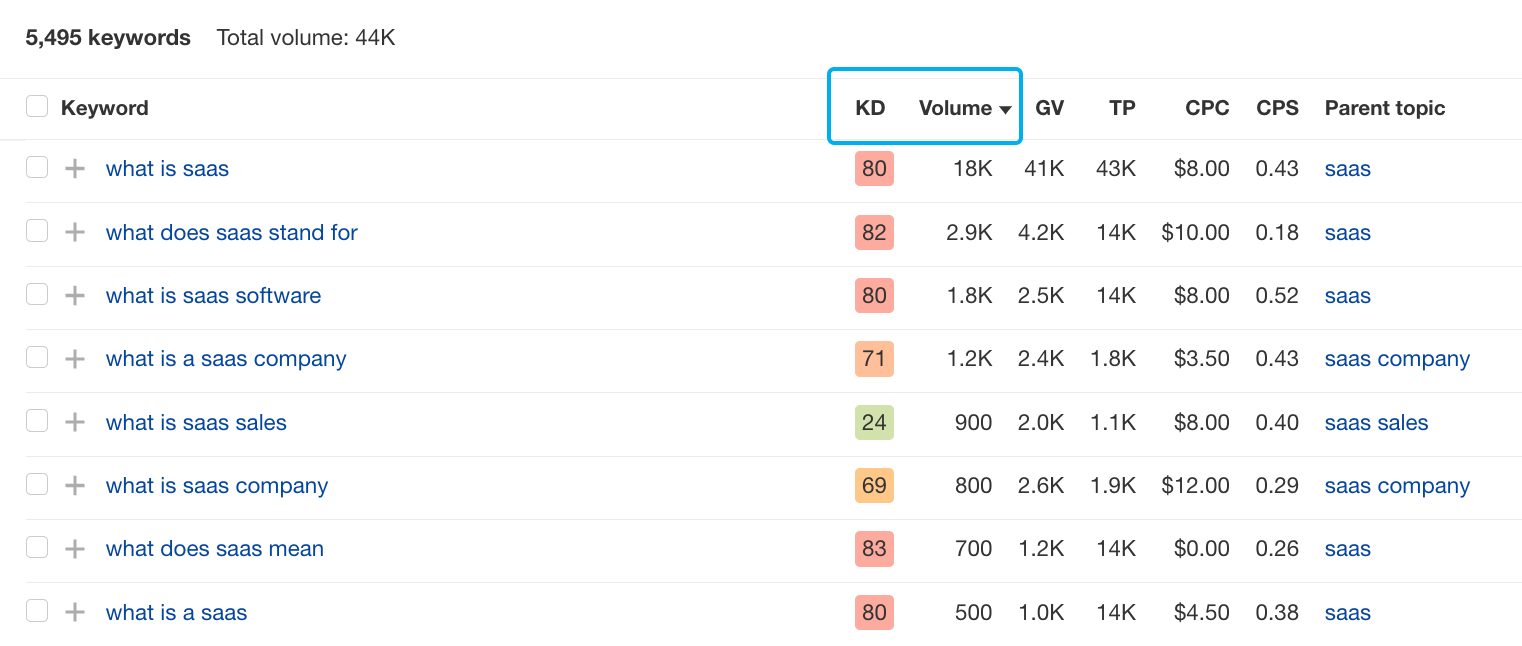
Furthermore, look up Related searches in Google search results:
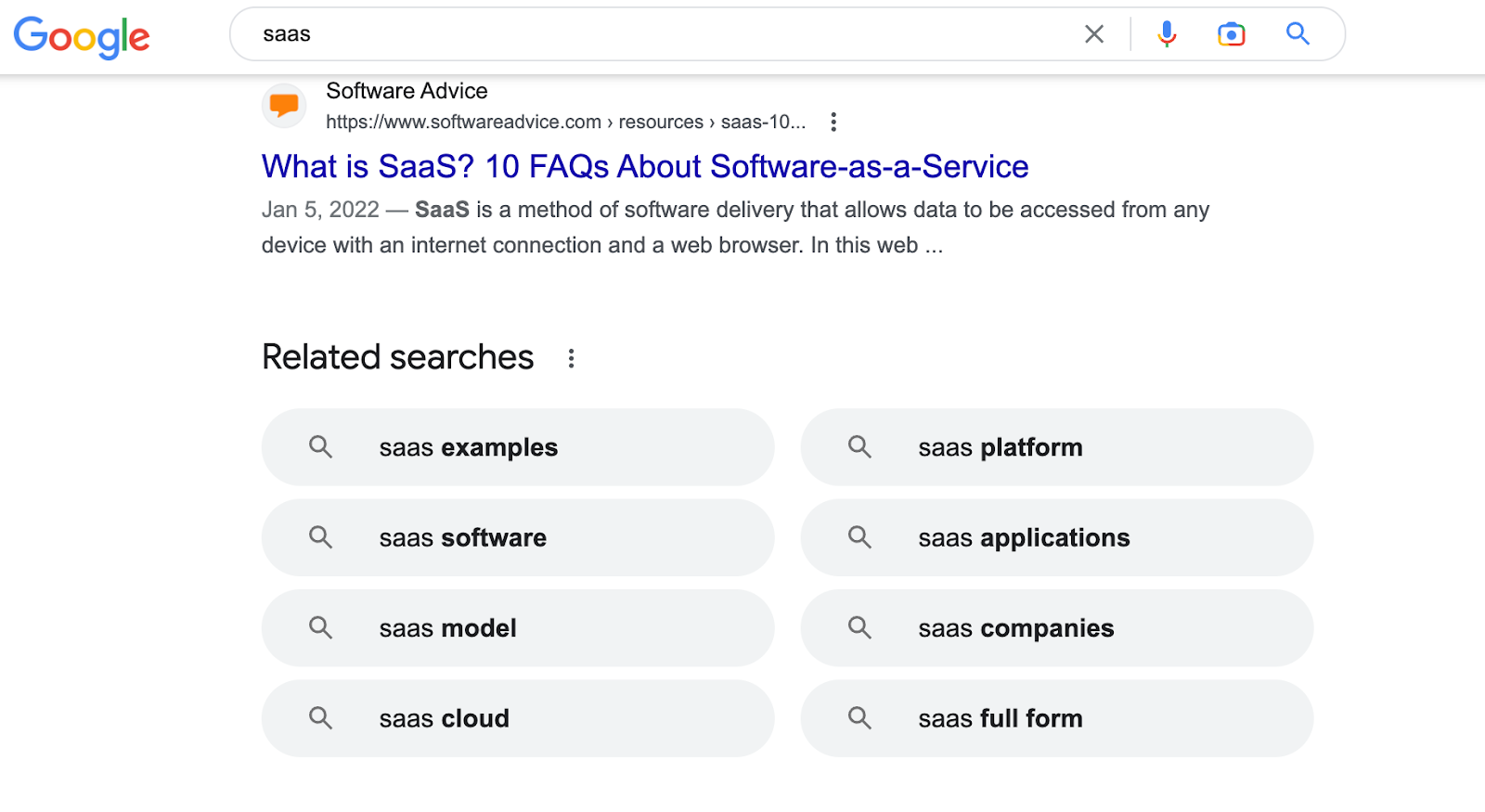
Check with ChatGPT :
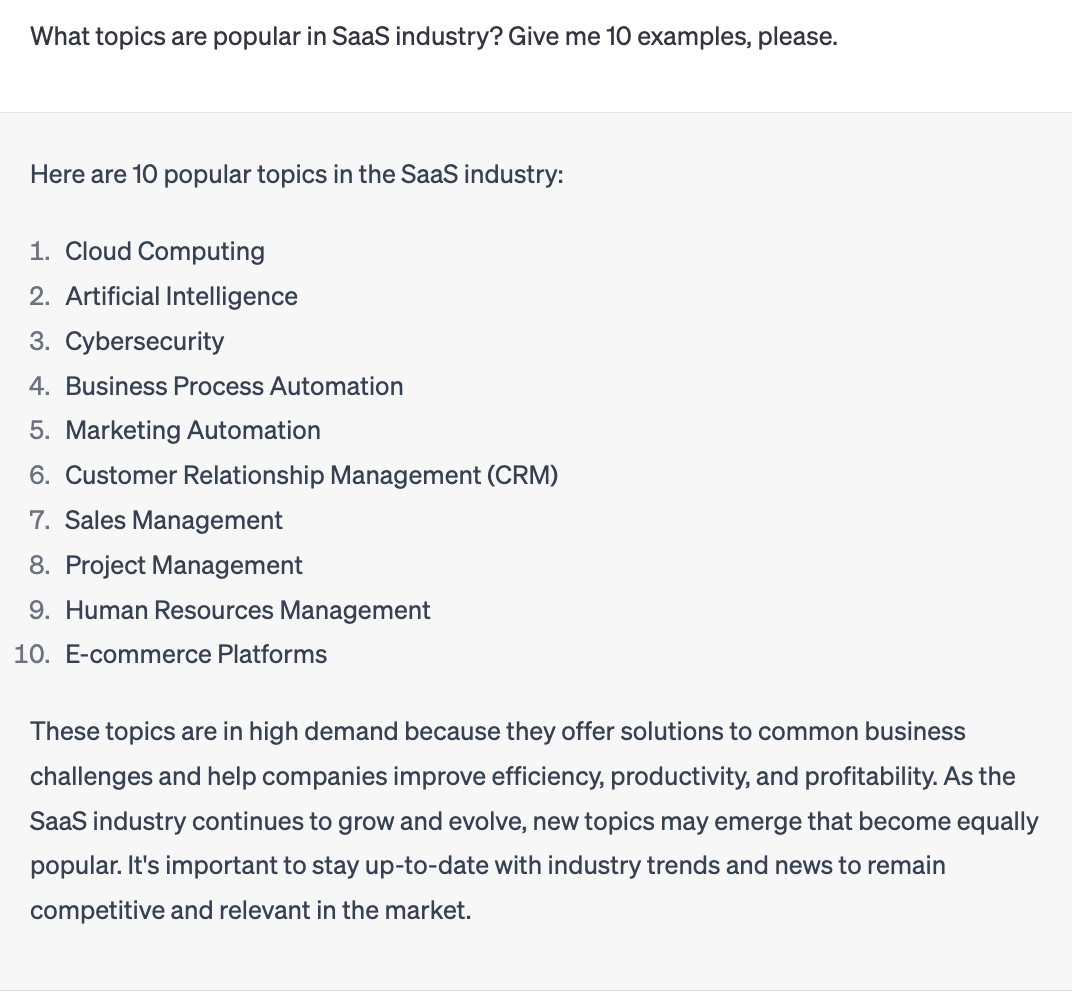
* ChatGPT will help you find inspiration. But ready-made themes should be checked for relevance and competition. If they suit you, they can be used to create content.
Tools we would like to recommend for additional content writing and editing
Surfer SEO
Surfer SEO will help you once you have chosen the topic and are ready to write your content. The AI-powered content optimization software will provide a list of keywords and LSI terms along with a post outline you can consider using.
The tool can also prompt on questions that users frequently ask that you can also include in your content. It comes with a content score that tells you if you are in the right range for optimization. Recently, they have introduced the ability to check your content for plagiarism.
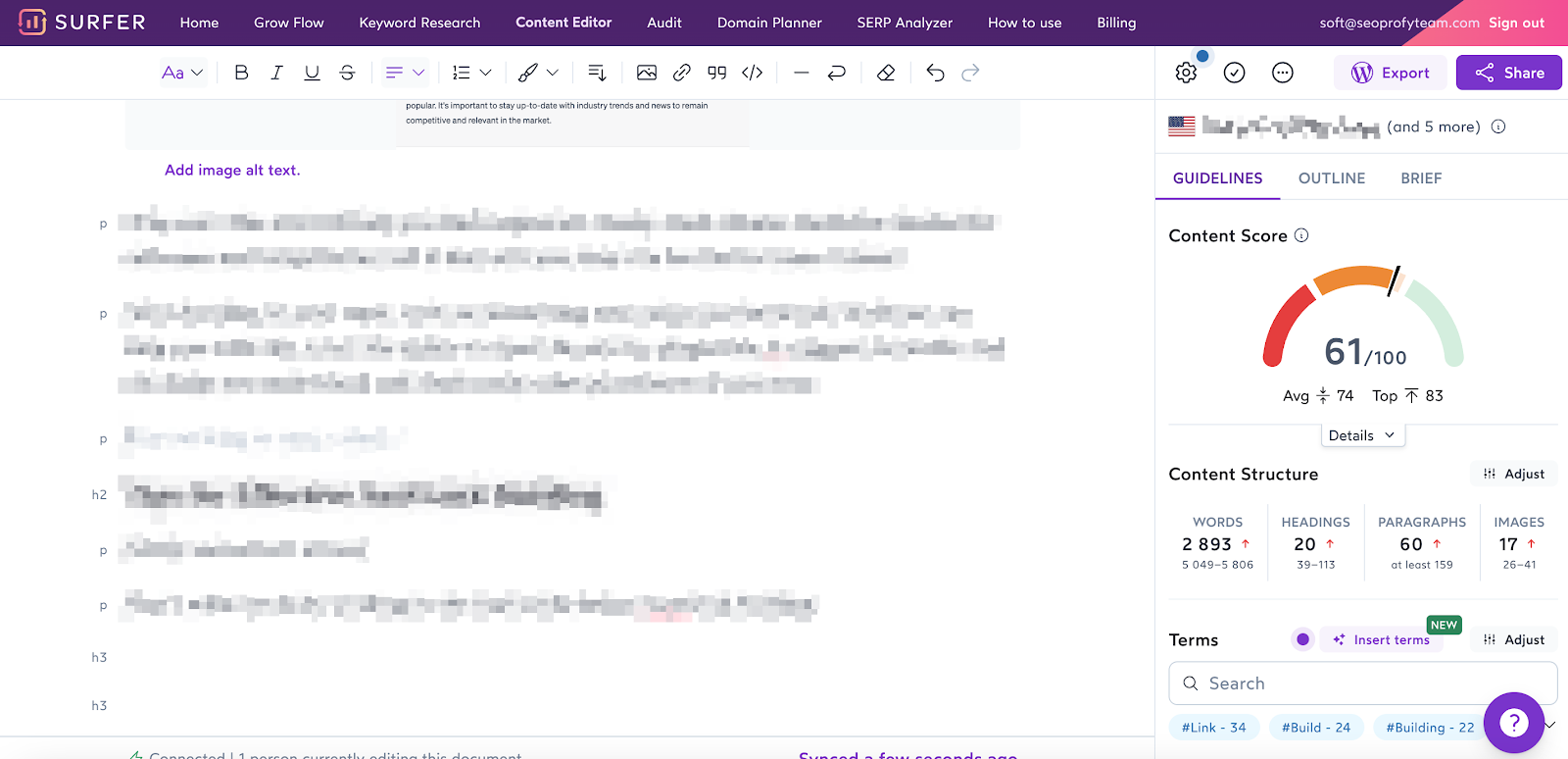
When using SurferSEO, don’t merely focus on including all the keywords as exact matches. It’s important but not your sole objective. The message —what you want to tell your audience —should be of more value than the exact occurrence of keywords in the text, because it will be evaluated first by the user, and then by search engines.
Grammarly
Grammarly will come in handy during the editing stage after you’re done with your initial draft. It analyzes your text, providing corrections for grammatical errors along with additional improvements on style and tone that you can make to make the writing more clear and understandable.
Tips for Effective SaaS Link Building
Monitor the Health of Your SaaS Links
It’s easy to get caught up in the chase for new backlinks while forgetting that hard-earned links may be easily lost due to avoidable mistakes. For instance, links often disappear once the webmaster decides to update an article that had a link to your site.
Additionally, it’s important to make sure that the links that you have built are delivering the most valuable link juice to prove their worth. For instance, the webmaster may change the linking attributes or the anchor text, reducing the benefit you would otherwise receive.
So, the lesson is that you need to keep track of all your links regardless of whether they were built naturally or through your paid link building efforts. Plus, you must respond swiftly to threats that seek to reduce the link juice that you would otherwise obtain, for instance, sending an email to the webmaster that you had a previous linking agreement with —if you detect that they’re not honoring their commitment.
Manually checking hundreds of links in your link profile every month will surely take a lot of time and effort. Plus, you can’t respond to any sudden changes in real-time. For some tips and tricks, you can use the Ahrefs Referring Domains tab with the “Lost” filter selected to track deleted links.
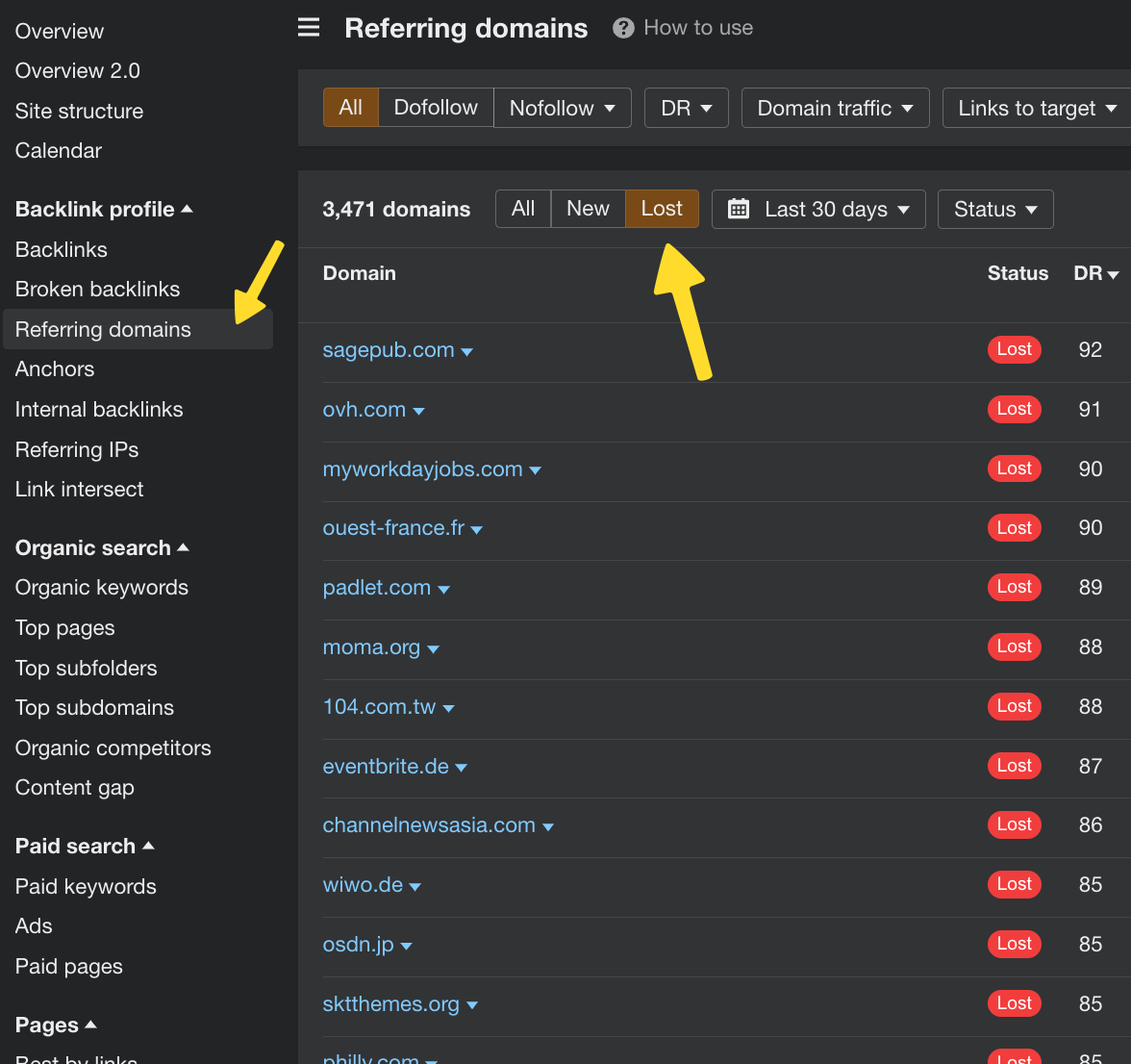
But note that most SEO tools are not properly set up to monitor links as their primary task, meaning that you could end up with fewer features. It’s actually better to use specific link monitoring tools, such as LinkChecker.Pro.
It’s ideal if you’re building links yourself or as part of a well-coordinated SaaS link building agency team. Your links will be checked on a day-to-day basis, and the tool monitors whether backlinks get deleted, go from dofollow to nofollow, have anchor text changed, etc.

Conduct Regular Analysis of Competitor Links
As you implement your link building campaign, it’s important to conduct regular analysis of competitors’ links while comparing their performance with your own site. For instance, you may need to know how many links your closest competitor is acquiring in a given month and if they’re the same type of links they have been building, or if it’s a new subset of links they have managed to acquire by implementing new strategies.
Now, some of the crucial site metrics that you will need to compare to your competitors include:
- Number of referring sites
- Growth in the rating of competitors’ domains (this indicates that more trust sites link to them)
- The amount of organic and referral traffic received
If their metrics are mostly growing and yours are not, then you are doing something wrong.

Track the Metrics of Your Target Pages
A target page is any page on your domain that receives external links. You should continuously update the content on your target pages to keep it relevant and fresh. Additionally, you need to pay attention to the technical performance and health of the pages because Google looks at more than the content in order to determine rankings.
One thing that could go wrong is if the pages start accumulating toxic links. To check if there are any spam sites linking to your top pages, you need to conduct a link audit at least once every 1-3 months.
There are a few pointers you can use to tell if a site is spammy:
- The site is ranking for keywords but has 0 traffic.
- The site does not rank for keywords.
- The site has a Domain Rating below 30.
Other signs of spam activity:
- Unexplained increase of incoming links to your site;
- Adult and casino related links pointing to your website.
You can then disavow the spammy links from your Google Search Console. This entails submitting a list of the domains and telling Google that you don’t want them to be counted in your site’s evaluation.
Regular link audits are also recommended as your site can suffer a negative SEO attack at any time. Vicious parties will orchestrate such attacks to induce a Google penalty that will erode all your gains.
Conclusion
Now you know how link building can lead to increased search rankings, a larger customer base, and a positive user experience for your SaaS company. An effective strategy begins with a deep understanding of your audience. To preserve link juice, monitor and disavow spammy links. Utilize a data-driven approach to make informed decisions throughout the entire link building process.
Building links in the SaaS niche can be challenging, so consider seeking professional guidance. Our team of experts can help you build lasting links to benefit your website. Contact us today to discuss your project’s unique challenges.






